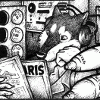
Design Overview of the
Gazelle Mk. III Armoured Scout Car (A403)
by: G. Wolfe
IntroductionThe Gazelle Armoured Scout Car is a Nordenfeld armoured fighting vehicle designed and built for reconnaissance purposes. It first entered service in the Nordenfeld Imperial Land Army in 767 and had been exported to over 11 countries around the world, many were still in service on low-intensity conflicts around the world long after its production ceased in 775
DevelopmentMechanical Automotive, originally known as the Mechanical Auto-Carriages (MAC), began manufacturing steam-powered trams as early as 613. The firm started road vehicle production in 681 and has since been known as the leading manufacturer of heavy-duty trucks and commercial vehicles including the powerful Caravan prime movers and the ubiquitous Camel 4-ton trucks.
In 765 a request for proposal was issued by the Imperial Land Army detailing light armoured vehicle for the purpose of liaison and reconnaissance to supplement the existing fleet of Cavalier light cruiser tanks. The vehicle is required to have sufficient power and agility to traverse rugged terrain and obstacles and reach 70 kph on flat ground - yet light and small enough to be air-transportable. The Imperial Land Army had always preferred reconnaissance by stealth over reconnaissance by force, therefore, a low-profile vehicle with light armament was desirable.
When people from Mechanical Automotive caught wind of the ILA's request for proposal, an armoured car design was promptly put together along with a prototype for comparative trial against competing designs from Imperial Motors and Newham Arsenal, both of which submitted a convertible light tank design. In the end, Mechanical Automotive's armoured car design was accepted - the Mechanical 'Gazelle' being the result.
In August 767, the design was finally standardized as the Armoured Scout Car, Gazelle Mk. I (A401). Mechanical Automotive was awarded a contract for 550 first production vehicles with an additional 250 built under license by Harold and Sons. Production of the Gazelle was finally completed in 775, after eight years of continuous production, by which time 6,687 vehicles of all types had been built.
DesignThe Gazelle hull was a full monocoque structure made of welded 15 to 20 mm thick rolled homogenous steel plates and divided into two compartments separated by a steel firewall. The front section formed the truncated lozenge-shaped fighting compartment with slightly sloped sides, while the rear section formed the engine compartment with mostly vertical side walls. The hull plates, while thinner than Cavalier armours, were lighter and provide sufficient protection against shrapnel and small arms fire up to 20mm calibre. The driver was posted in the center with an outward-folding hatch and sight block. Two other sight slits were present on each side, covering the front angle.
Power was provided by a 5.1-litre, liquid-cooled CI510T inline-4 compression-ignition engine developing 110 brake horsepower. The power from the engine was transmitted through a fluid flywheel and Wilson pre-selector gearbox to an H-drive differential, which distributes power to individual wheel stations. The Gazelle has permanent four-wheel drive with independent wheel stations mounted on coil-spring double wishbone suspension, giving exceptional mobility over a wide range of terrain. Fuel consumption is about 2.4 kilometres per litre, giving an operational range of 312 kilometres on a full tank.
Gazelle tyres are mounted onto a 406mm (16 in) diameter split rim, comprising two parts which are clamped together by bolts. The tyres themselves were of the run-flat type, with inner solid rubber support to enable the vehicle to continue to be driven at reduced speeds when the tyres were deflated.
The turret ring was centered on the vehicle's center of weight. Early Mk. I have a turret ring diameter of 1,200 mm while Gazelle Mk. II-III has a diameter of 1,400mm to accommodate larger two-men turret. The turret itself differs from marks to marks. Gazelle Mk. I was designed with stealth in mind, It has a conical-shaped low-silhouette turret equipped with twin 15mm G30 medium-calibre machine guns. The turret lacked turret basket and has to be manually operated by the commander who also doubles as the gunner.
Gazelle Mk. II has an enlarged turret and was up-gunned with single G132 30mm autocannon and a single co-axial G24 6.35mm rifle-calibre machine gun. The 30mm was clip-fed with 5 rounds clip and could fire a variety of AP and HE rounds, making it more effective against soft targets. The Mk. II turret introduces a dedicated gunner position.
Design of the Gazelle Mk. III was a radical departure from its original purposes. In addition to reconnaissance and liaison role, the Mk. III also designed to fill flank/rear security and counter-reconnaissance role. The new enlarged two-men turret, designed and manufactured by the Galena Extraction Company (therefore known as the GEC turret), featured a 50mm G4A1 L/50 High-velocity anti-tank gun and a single co-axial G24 machine gun, which allowed the Mk. III to effectively engage enemy light armours and reconnaissance vehicles.
Design for fire support variants of Gazelle was also pursued. Gazelle Mortar Carrier was developed in 770 in an attempt to increase the mobility of 120m mortar. It had an open-topped hull and carried a single 120mm Mortar inside its fighting compartment, 560 vehicles of this type were produced and used mainly by light infantry brigades.
A wheeled tank destroyer variant, the Gazelle Mobile Gun Carrier, was also proposed and would have featured a much bigger turret equipped with 90mm G7A5 L/50 High-velocity gun, a lightweight variant of G7A1 gun used by Caracal Cruiser tank. a single prototype was assembled from the existing Mk. III chassis in 773 but was soon abandoned due to unsolved stability issues.
Specification (Gazelle Mk.III)Type : Armoured Scout Car
Place of origin : Nordenfeld Empire
In service : 767 - 788 (All variants)
Manufacturer : Mechanical Automotive, Harold and Sons
Produced : 767 - 775 (All variants)
Number built : 6,687 (All variants)
Weight : 5 short tons (4.53 tonnes 4.46 long tons)
Length : 4.8 meters (15 ft 8.9 in)(hull)
Width : 2.3 meters (7 ft 6.6 in)
Height : 2.4 meters (7 ft 10.0 in)
Crew : 3
Main Armament : 50mm G4A1 L/50 High-velocity gun
Secondary Armament : 6.35mm G24 rifle-calibre machine gun
Engine : Mechanical Automotive CI510T.69 4-Cylinder, turbocharged CI engine, 110 bhp (82 kW)
Power/weight : 22 bhp/st (18.1 kW/tonne)
Transmission : 5-speed Wilson pre-selector gearbox, H-drive differential
Suspension : Double wishbone, Damped coil spring
Operational range : 312km (340 miles)
Speed : 70 km/h (43.4 mph)(road)
Category All / All
Species Unspecified / Any
Size 1280 x 772px
File Size 240.4 kB
Listed in Folders
Well, now that you said that... https://www.furaffinity.net/view/36377324/
Not only modeler, but I'm also sure a dedicated machinist with adequate tools and welding equipment would be able to build this vehicle from scratch. I used a lot of off-the-shelf components for the design including Perkins T4.318 diesel (of Maffey-Ferguson MF 1080 tractor) and a lot of components from Ferret armoured car (Mainly steering gear and powertrain).
If you need one, I have a 1/35 three-view drawing of the vehicle, which at that scale is only about 13 cm long
If you need one, I have a 1/35 three-view drawing of the vehicle, which at that scale is only about 13 cm long
Your work is always a delightful surprise when I see it in my notifications, and this one doesn't disappoint either. I could read about your setting and its equipment all day! I may have asked this before, but how do you come up with the technical details etc.? My immediate thought was that you might take a hefty dose of inspiration from real life vehicles (such as the Fox mentioned elsewhere in the comments), but it's clear a lot of thinking goes into this that might not be present if you were simply combining things.
If I may be so bold, will we see more illustrations of your machines in action? They're too good to be left in technical drawings alone! Though I do understand that this level of detail takes an immense amount of effort and time, and that complexity tends to balloon exponentially with the more things you add to an illustration - so feel free to disregard my query.
If I may be so bold, will we see more illustrations of your machines in action? They're too good to be left in technical drawings alone! Though I do understand that this level of detail takes an immense amount of effort and time, and that complexity tends to balloon exponentially with the more things you add to an illustration - so feel free to disregard my query.
Thanks! Learning descriptive geometry is a good way to start, its the foundation and requires some mental gymnastic to figure out at first (and i still do sometimes) but after you got around it, all is left is erasing parts you don't want
https://books.google.co.id/books/about/Aircraft_Design_of_WWII.html?id=CSsCDgAAQBAJ&source=kp_book_description&redir_esc=y
This book also helps with inspiration, had this book for a while actually
https://books.google.co.id/books/about/Aircraft_Design_of_WWII.html?id=CSsCDgAAQBAJ&source=kp_book_description&redir_esc=y
This book also helps with inspiration, had this book for a while actually

 FA+
FA+
















Comments